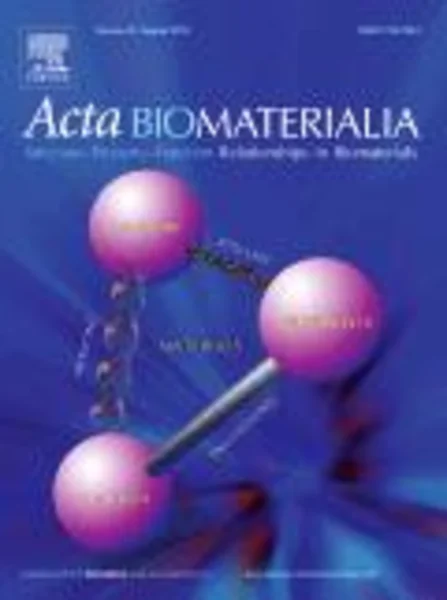-
cohesive behavior of soft biological adhesives: experiments and modeling
جزئیات بیشتر مقاله- تاریخ ارائه: 1392/01/01
- تاریخ انتشار در تی پی بین: 1392/01/01
- تعداد بازدید: 814
- تعداد پرسش و پاسخ ها: 0
- شماره تماس دبیرخانه رویداد: -
extracellular proteins play a key role in generating and maintaining cohesion and adhesion in biological tissues. these “natural glues” are involved in vital biological processes such as blood clotting, wound healing and maintaining the structural integrity of tissues. macromolecular assemblies of proteins can be functionally stabilized in a variety of ways in situ that include ionic interactions as well as covalent crosslinking to form protein networks that can extend both within and between tissues. within tissues, myriad cohesive forces are required to preserve tissue integrity and function, as are additional appropriate adhesive forces at interfaces both within and between tissues of differing composition. while the mechanics of some key structural adhesive proteins have been characterized in tensile experiments at both the macroscopic and single protein levels, the fracture toughness of thin proteinaceous interfaces has never been directly measured. here, we describe a novel and simple approach to measure the cohesive behavior and toughness of thin layers of proteinaceous adhesives. the test is based on the standard double-cantilever beam test used for engineering adhesives, which was adapted to take into account the high compliance of the interface compared with the beams. this new “rigid double-cantilever beam” method enables stable crack propagation through an interfacial protein layer, and provides a direct way to measure its full traction–separation curve. the method does not require any assumption of the shape of the cohesive law, and the results provide abundant information contributing to understanding the structural, chemical and molecular mechanisms acting in biological adhesion. as an example, results are presented using this method for thin films of fibrin—a protein involved in blood clotting and used clinically as a tissue bio-adhesive after surgery—with the effects of calcium and crosslinking by factor xiii being examined. finally, a simple model is proposed, demonstrating how a bell-shaped cohesive law forms during the failure of the fibrin interface based on an eight-chain model whose structure degrades and changes configuration with stress.
مقالات جدیدترین رویدادها
-
استفاده از تحلیل اهمیت-عملکرد در ارائه الگوی مدیریت خلاقیت سازمانی و ارائه راهکار جهت بهبود
-
بررسی تاثیر ارزش وجوه نقد مازاد بر ساختار سرمایه شرکت های پذیرفته شده در بورس اوراق بهادار تهران
-
بررسی تأثیر سطح افشای ریسک بر قرارداد بدهی شرکت های پذیرفته شده در بورس اوراق بهادار تهران
-
بررسی تأثیر رتبه بندی اعتباری مبتنی بر مدل امتیاز بازار نوظهور بر نقد شوندگی سهام با تأکید بر خصوصی سازی شرکت ها
-
تأثیر آمیخته بازاریابی پوشاک ایرانی بر تصویر ذهنی مشتری پوشاک ایرانی (هاکوپیان)
-
تاثیر نوع استراتژی و توانمندی های سازمانی بر عملکرد: نقش میانجی تکنیک های حسابداری مدیریت
-
ارزیابی توزیع فضایی بافت فرسوده در شهر آبدانان و ارائه الگوی بهینه مداخله در آن
-
مدل سازی استاتیک مخزن دالان در یکی از میادین جنوب ایران
-
تعیین پارامتر های موثر در حمل و نقل مطلوب شهری با استفاده از روش ahp نمونه موردی شهر شیراز
-
سیرالولیاء؛ مستندترین تذکره در شرح احوال مشایخ سلسله چشتیه
مقالات جدیدترین ژورنال ها
-
مدیریت و بررسی افسردگی دانش آموزان دختر مقطع متوسطه دوم در دروان کرونا در شهرستان دزفول
-
مدیریت و بررسی خرد سیاسی در اندیشه ی فردوسی در ادب ایران
-
واکاوی و مدیریت توصیفی قلمدان(جاکلیدی)ضریح در موزه آستان قدس رضوی
-
بررسی تاثیر خلاقیت، دانش و انگیزه کارکنان بر پیشنهادات نوآورانه کارکنان ( مورد مطالعه: هتل های 3 و 4 ستاره استان کرمان)
-
بررسی تاثیر کیفیت سیستم های اطلاعاتی بر تصمیم گیری موفق در شرکتهای تولیدی استان اصفهان (مورد مطالعه: مدیران شرکتهای تولیدی استان اصفهان)
-
صنعت خودروی تجاری ایران از منظر بازگران: راهکارهایی برای توسعه
-
بررسی تاثیر وابستگی به گروه تجاری بر انتخاب حسابرس
-
واکاوی تهدیدها و فرصت های جذب سرمایه گذاری در صنعت پتروشیمی از دیدگاه کارکنان شپترو
-
the management of capital assets life cycle in petrochemical industry
-
influence of polypropylene length on stability and flow of fiber-reinforced asphalt mixtures




سوال خود را در مورد این مقاله مطرح نمایید :